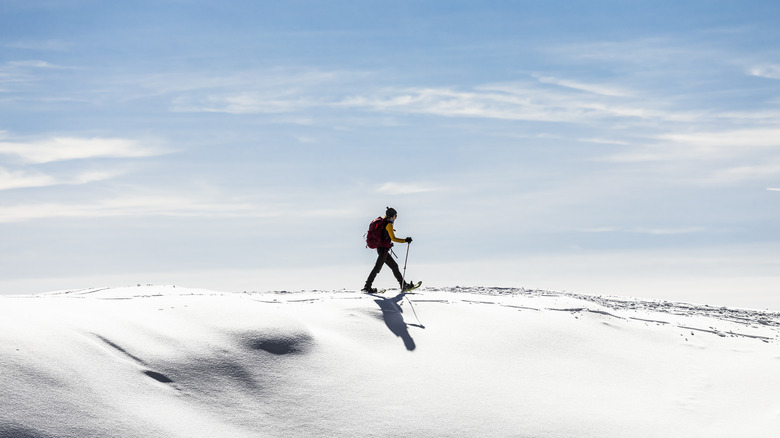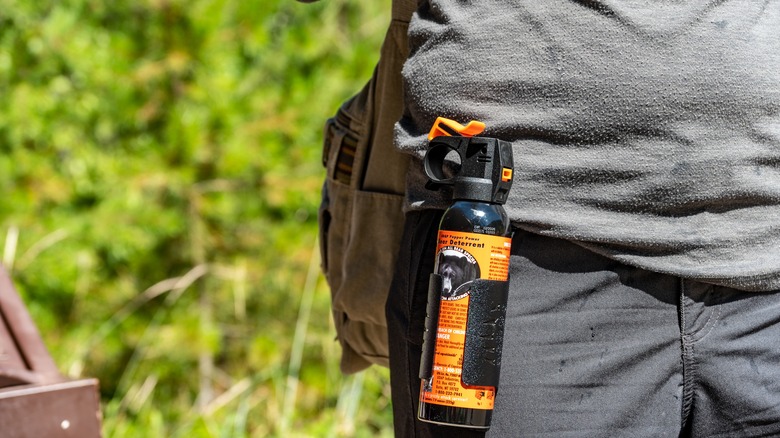This Dangerous Hiking Trail Is So Long It Isn't Contained To One Country
When preparing for a hike that takes you through forests, past rivers and creeks, along valleys, and up to lookouts, you might want to refer to a checklist of the best hiking gear. These items typically include hiking poles, a water bladder, comfortable hiking boots, and a windbreaker. A passport wouldn't come to mind, but it's exactly what you'll need if you decide to hike the entire length of the Chilkoot Pass Trail. Therefore, make sure it's handy and valid.
However, it's not just an expired passport that could prevent you from finishing this course. The Chilkoot Pass has a reputation for being extremely perilous, with a history of fatalities. The Chilkoot Trail goes from Dyea, Alaska, in the United States to Lake Bennett, British Columbia, in Canada, clocking in at a whopping 33 miles. To this day, authorities have had to issue warnings to hikers about the extreme weather conditions and dangerous animals that populate the area. Here's why you shouldn't underestimate the hazards of hiking the Chilkoot Pass.
Avalanches can occur on the Chilkoot Trail
Parks Canada provides a comprehensive guide to hiking the Chilkoot Pass due to the unpredictable nature of the terrain and extreme weather conditions that can pose a serious threat to hikers. It showcases several wet and rocky sections along the trails and notifies hikers that they will have to cross creeks on foot. But the forewarnings don't stop there. The pass could be snowy, rainy, or very windy in July, which could lead to hypothermia. Park Canada also recommends setting out early morning for a grave reason: snowdrifts and snowpacks are more stable at dawn and less likely to trigger an avalanche. Yes, you read that right. Avalanches are a real risk here.
One of history's deadliest avalanches occurred at the Chilkoot Pass in 1898 during the Klondike Goldrush. The avalanche hurtled upon thousands of people, and the mound of snow measured 150 yards long and 50 feet deep. Per reports, 52 bodies were eventually pulled from the snow — however, the National Park Service puts the death toll at 65 — and some survivors were even buried alive for up to 19 hours. This occurred at the trail's highest elevation, 3,500 feet, where the terrain is the most volatile and is still a threat today.
Bears populate the area
It's not just the unpredictable weather conditions that make the Chilkoot Pass a dangerous course for even the most seasoned hikers. The trail runs from Alaska into British Columbia, and if there's one thing those two areas are known for, it's a proliferation of bears. In 2016, local radio station KHNS reported that the entire stretch of the Canadian side of the trail had to be closed because a bear broke into a nearby shack and raided a pantry. The trail only reopened once a black bear was "shot out of absolute necessity," per KHNS. Then, in October 2019, the outlet, once again, reported that a man had to be airlifted to a hospital after a bear bit him as he hiked along the trail. The news agency also points out a different man also sustained injuries earlier that month after a bear attack. So, hungry and belligerent bears are not uncommon along the Chilkoot Trail.
Parks Canada and the National Parks Service recommend that hikers carry bear spray at all times when hiking along the Chilkoot Pass due to the likelihood of encountering a bear. Furthermore, there's no cell service along the hike, so should you be injured, you will need a satellite phone. So, if you're keeping track, your must-pack list includes bear spray, a satellite phone, a passport, and the ability not to trigger an avalanche. With all this in mind, hiking the Chilkoot Pass is not for the faint of heart.


